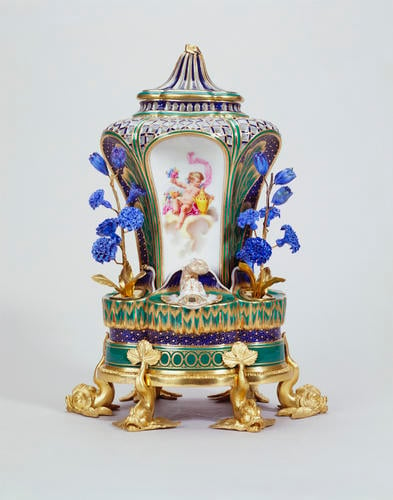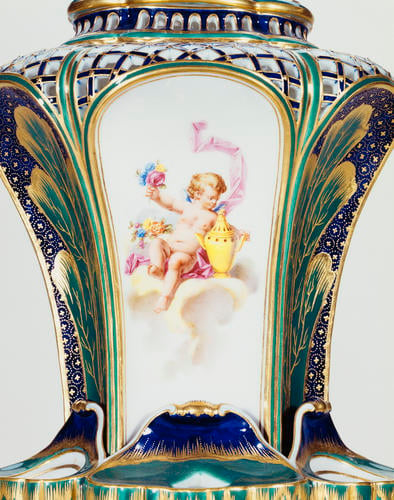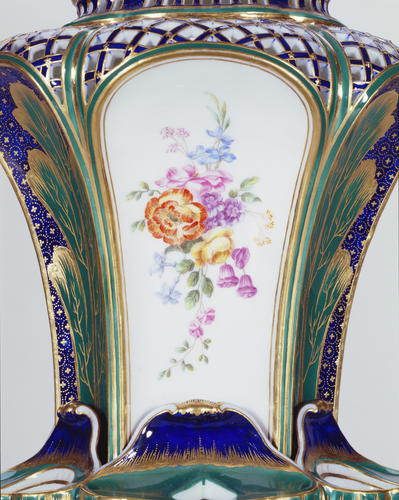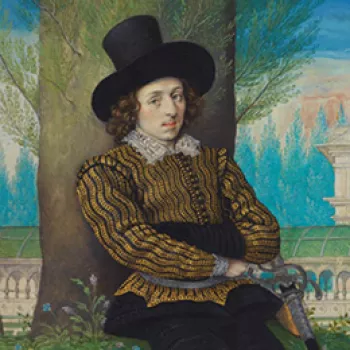Pot-pourri fontaine or pot-pourri à dauphins c. 1760
Soft-paste porcelain, bleu lapis and apple green ground, gilded decoration and gilt bronze | 33.1 x 24 x 19.5 cm (with fittings) | RCIN 36074




-
The vase has two ground colours and is richly gilded. The predominant ground colour is dark blue (bleu lapis) overlain by a repeating pattern of gold crosses (formed by five dots) within a circle of dots; the subsidiary colour is a plain apple green. It is supported on a plinth chased with a stylised foliate and gadrooned rim and raised on six dolphin feet, all of bronze chased and gilt. Painted on the front in polychrome is a putto seated on a cloud and partly draped with a fluttering swathe of pink drapery – in his right hand he holds a posy of flowers and in his left he clutches a cassolette; on the reverse, is a posy of flowers comprising a rose, an anemone and bell-shaped flowers – all allegorical of the sense of smell and, thus, appropriate to the pot-pourrie.
The slightly projecting broad green band round the base of the reservoir is decorated in the centre of the front and back with panels of gold circles. The moulded upper band in green and gold simulates water cascading over the rim of the basin. Prominent upright acanthus leaves, in green and gold on a blue ground, fill four of the concave panels of the pot-pourri section.
The concept behind the creation of this vase was sophisticated. When the reservoir was full of water and the four flowering hyacinth bulbs filled their allotted spaces the pot-pourri was dormant. Only when the seasons changed and the plants were replaced by blue porcelain flowers in tubs, would the pot-pourri vase have come into its own. Then the vessel would have been filled with sweet-scented essences, chosen to evoke the smell of particular flowers, giving the illusion that live plants continued to inhabit this vessel, distilling their scent even in winter months.
Text adapted from French Porcelain: In the Collection of Her Majesty The Queen, London 2009Provenance
Bought in Paris by François Benois, its receipt was recorded at Carlton House on 8 September 1827: ‘[No.] 12 [Custom Ho. Sent from Paris by Benois Septr 8th 1827] A Porcelaine Vase for Flowers. The Top takes off. Painted in Figures & Flowers, on Green Ground, mounted upon an Or Molu Stand with Dolphin Feet, 4 wreaths of Blue Porcelaine Flowers, & Two Porcelaine Dolphins, Detached, belonging to this Vase’; annotated in pencil: ‘Delivered to Mr Watier cost £50’. Recorded in the Confectionary, Carlton House, in 1826 under No.291: ‘A Porcelain Vase for Flowers, top takes off, painted in Figures and Flowers, on green ground mounted upon an ormolu stand with Dolphin feet; – 4 Wreaths of blue Porcelain Flowers and 2 detached Dolphin Handles belong to this Vase’.
-
Creator(s)
(porcelain manufacturer)(nationality)Acquirer(s)
-
Medium and techniques
Soft-paste porcelain, bleu lapis and apple green ground, gilded decoration and gilt bronze
Measurements
33.1 x 24 x 19.5 cm (with fittings)
29.7 x 16.2 x 14 cm (whole object)
Other number(s)
Alternative title(s)
Combined flower and pot-pourri vase and cover
Place of Production
Sèvres [France]









